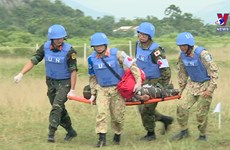Localities target leprosy reduction
All provinces and cities are expected to achieve key indicators
related to leprosy elimination by 2015, according to the agency that
provides technical guidance to hospitals for the national leprosy
prevention programme.
All provinces and cities are expected to achieve key indicators
related to leprosy elimination by 2015, according to the agency that
provides technical guidance to hospitals for the national leprosy
prevention programme.
There are four main criteria: a leprosy prevalence rate of less than 0.2 per 10,000 population; less than one new case per 100,000; less than 15 percent degree-two disability among new patients; and all medical staff and local authorities should have basic knowledge of the disease.
Fifty two provinces and cities achieved the four indicators by 2013.
Quang Ngai, Binh Dinh, An Giang, Kien Giang, Binh Phuoc, and Tay Ninh hope to achieve them by the end of this year, and the remaining city and provinces — Ho Chi Minh City, Ninh Thuan, Binh Thuan, Gia Lai, and Kon Tum — by the end of 2015.
Deputy Minister of Health Nguyen Thi Xuyen said that for the purpose they should focus on activities to detect new cases and rehabilitate patients with leprosy.
The rate of new cases decreased from 1.04 per 100,000 in 2004 to 0.29 last year, Assoc Prof Dr Tran Hau Khang, manager of the country's leprosy prevention programme and Director of the National Hospital Of Dermato-Venerelogy, told a national meeting on accelerating leprosy elimination held in central Ninh Thuan province on June 25.
The prevalence rate also fell from 0.10 per 10,000 in 2004 to 0.02. The rate of new patients with degree-two disability dropped from 16.9 percent to 16.54 percent, but the speed of change was slow, he said.
The country has 18,000 leprosy patients with degree-two disability, one of the challenges facing the programme, he said.
He called on provinces and cities that have achieved the targets to continue with the programme.
But a drop in the funding for the programme is causing difficulties especially for those provinces and cities planning to achieve the targets by 2015.
Xuyen called on health officials in provinces and cities to take the initiative to carry out examinations to detect new cases early, treat patients with free multi-drug therapy, and reduce disabilities.
Dissemination of information about the disease, prevention of disabilities, and rehabilitation should be strengthened and health officials on the programme should be provided training, she added.-VNA
There are four main criteria: a leprosy prevalence rate of less than 0.2 per 10,000 population; less than one new case per 100,000; less than 15 percent degree-two disability among new patients; and all medical staff and local authorities should have basic knowledge of the disease.
Fifty two provinces and cities achieved the four indicators by 2013.
Quang Ngai, Binh Dinh, An Giang, Kien Giang, Binh Phuoc, and Tay Ninh hope to achieve them by the end of this year, and the remaining city and provinces — Ho Chi Minh City, Ninh Thuan, Binh Thuan, Gia Lai, and Kon Tum — by the end of 2015.
Deputy Minister of Health Nguyen Thi Xuyen said that for the purpose they should focus on activities to detect new cases and rehabilitate patients with leprosy.
The rate of new cases decreased from 1.04 per 100,000 in 2004 to 0.29 last year, Assoc Prof Dr Tran Hau Khang, manager of the country's leprosy prevention programme and Director of the National Hospital Of Dermato-Venerelogy, told a national meeting on accelerating leprosy elimination held in central Ninh Thuan province on June 25.
The prevalence rate also fell from 0.10 per 10,000 in 2004 to 0.02. The rate of new patients with degree-two disability dropped from 16.9 percent to 16.54 percent, but the speed of change was slow, he said.
The country has 18,000 leprosy patients with degree-two disability, one of the challenges facing the programme, he said.
He called on provinces and cities that have achieved the targets to continue with the programme.
But a drop in the funding for the programme is causing difficulties especially for those provinces and cities planning to achieve the targets by 2015.
Xuyen called on health officials in provinces and cities to take the initiative to carry out examinations to detect new cases early, treat patients with free multi-drug therapy, and reduce disabilities.
Dissemination of information about the disease, prevention of disabilities, and rehabilitation should be strengthened and health officials on the programme should be provided training, she added.-VNA













